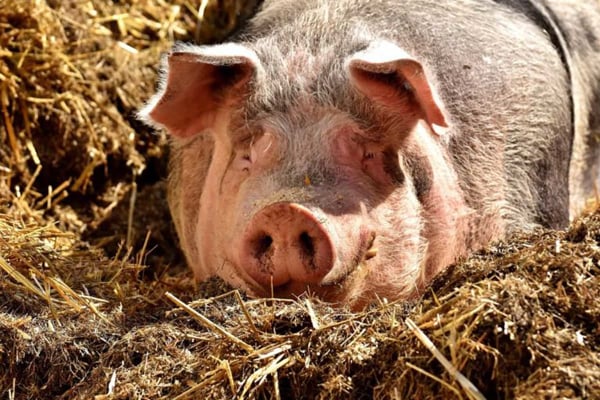Prime
How to get the best out of your pigs at low cost

A pig. PHOTO/FILE
What you need to know:
- Pig farmers should plant Napier grass, maize, sweet potatoes and cassava.
- The last two crops are of great benefit as the farmer will harvest the tubers and feed the vines and leaves to the pigs.
Pigs literally bring home the bacon. However, for them to do so farmers need to ensure they are fed a balanced diet.
Having received numerous queries on feed management and the challenges farmers face, I felt this was a key area that needed to be addressed.
Improving productivity
How can a farmer improve his pigs’ productivity, weight and make reasonable profits from this business? Proper feeding is key. Most farmers moan that feeds are the most costly part of pig farming. Any savings related to feeds would be a relief.
Pig feed availability, accessibility, affordability and sustainability are the common challenges farmers face.
Presently, farmers bear the brunt of increased costs due to the value added tax. The available commercially-produced feeds are pig creep pellets for piglets, sow and weaners for breeders and pig finishers for fatteners.
Costly feeds
These feeds are relatively expensive, as presently, a 50-kilogramme bag of sow weaner is retailing at Shs50,000. This bag often lasts for approximately 15 days if exclusively fed to a sow at an average of three kilos a day.
Cumulatively, the total costs per month are beyond the reach of many small-holder farmers. The best way to reduce these costs would be for a farmer to combine commercially produced feeds with home-prepared ones. Easy-to-grow feeds — such as maize bran, sweet potato vines, cassava leaves, sunflower seeds and Napier grass — are some of the preferred choices since their production is sustainable.
Plant animal feeds
Pig farmers should plant Napier grass, maize, sweet potatoes and cassava. The last two crops are of great benefit as the farmer will harvest the tubers and feed the vines and leaves to the pigs.
Grocery by-products are also a relatively cheaper and can easily be sourced from vegetable markets. Another easily available and affordable feed, especially for pig farmers in rural areas, is posho mill waste that can be cooked or mixed with the other commercial feeds.
Different varieties of vegetables such as cabbages, pumpkins and fruits are also good pig feeds.
Feed the pigs twice a day
For pigs to gain good weight and improve productivity, farmers need to feed them at least two times a day depending on the different ages and nutritional needs of the pigs. The farmer must consider the feed rations and dietary requirements.
To ensure maximum weight gain, maize or wheat bran is highly recommended. Home-grown feeds need to be “processed” to some degree.
This basically means that the farmer may need to invest in a mill and mixer to ensure the splitting of grains and even mixing of different feed rations.
For a quick source of proteins, offals blood may be collected from local slaughterhouses and cooked with some maize meal before being offered to the pigs. It is recommended that a pig farmer, who collects these by-products from a slaughterhouse ensures that they are cooked thoroughly due to the often poor hygienic conditions in some slaughterhouses. Mukene fish (silverfish) is also another alternative protein source.
Managing piglets
Gilts (piglets) require at least 2.5 kilogrammes per day while pregnant sows and boars need three kilogrammes. It is paramount to ensure that the feeding and watering troughs are well-cleaned to prevent diseases. Contrary to the common misconception that pigs like dirt, a clean environment will result in a happy pig and consequently maximum returns. The market for pigs is insatiable.
Farmers can increase their income from pigs by 34 percent through proper management of piglets on their farms.
According to research conducted by livestock scientists at, a sow (female pig) has the ability to give birth to 12 piglets but only eight survive to maturity due to factors such as cold and suffocation by the mother pig among others.
At birth, disinfecting the umbilical cord with iodine five per cent to prevent disease infection.
Keep them warm
Piglets are affected by cold in the first two to three weeks after birth due to insufficient fat layers on their bodies to protect them.
To keep them warm, provide bedding (grass or wood cravings) or artificial heating such as infrared bulbs.
Clip the piglet’s teeth within 24 hours to avoid damage to the sow’s udder when suckling.
On the third day inject the piglets with iron to reduce incidences of anaemia attack.
Death by suffocation is caused when the sow lies on the piglets. This can be reduced by building a creep area for the piglets where they can move slowly without interference. Tag the piglets’ ears for easy identification and record keeping.
At week eight when the pigs weigh 20 kilogrammes, separate them from the sow by weaning (withdrawing the supply of mother’s milk). The pigs can then be put in a group of 10 to 12 depending on their weights.
Separate small from big ones
The small pigs are kept away from the big ones to reduce fighting. Only piglets from one sow are mixed together to reduce weight loss and stress.
When mixing piglets from different sows apply used engine oil on their skin to get rid of the identification scent.
Pigs are reared for their meat (pork) while their skin is used to make leather and their hairs (fur) are used to make brushes.



